by Joe Domaleski | Mar 18, 2024 | Blog, Business, Columnists, Community, Front Page, News Center, Opinion, Top News
Have you ever looked at a piece of art, read a great story, listened to inspiring music, or looked at a funny advertisement and thought, “That’s really creative”? Have you ever looked at a clever piece of “redneck engineering,” smiled, and thought, “That’s a creative way to solve that problem”? In many fields, except perhaps accounting, creativity is thought of as being something good. So, what is creativity, and why does it matter?
I asked some of my staff for their definitions of creativity:
“I think of creativity as a combination of imagination and knowledge.” – Hollie
“I like to think of creativity as using our minds to make something new out of what already exists.” – Erica
“I think creativity is being able to express your thoughts, ideas, and emotions be it in the way we dress, work, speak, and live our lives in a way that represents who we are and how our minds interpret those thoughts, ideas, and emotions.” – Christina
“I would define creativity as the ability to piece together aspects of different experiences to make something new and innovative.” – Zavion
“I think creativity is the ability to use your imagination to create something new and then the ability to express that thought in different mediums and formats.” – Janine (our Creative Director)
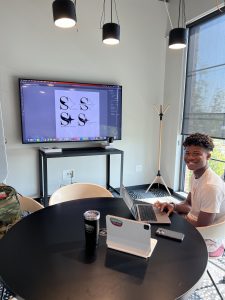
CFC graphic design intern Zavion Green working on creative logo designs for a local nonprofit. Photo/Joe Domaleski
Some common themes expressed in these definitions are:
- Imagination
- New
- Ideas
- Knowledge
- Innovation
- Assembly
- Expression
- Emotion
- Thoughts
- Artistry
- Ingenuity
One of my favorite quotes about creativity comes from the late Steve Jobs, Founder and CEO of Apple:
“Creativity is just connecting things. When you ask creative people how they did something, they feel a little guilty because they didn’t really do it, they just saw something. It seemed obvious to them after a while. That’s because they were able to connect experiences they’ve had and synthesize new things. And the reason they were able to do that was that they’ve had more experiences or they have thought more about their experiences than other people. Unfortunately, that’s too rare a commodity. A lot of people in our industry haven’t had very diverse experiences. So they don’t have enough dots to connect, and they end up with very linear solutions without a broad perspective on the problem. The broader one’s understanding of the human experience, the better design we will have.” – Steve Jobs, Make Something Wonderful
In most of the definitions and themes above, creativity was associated with taking existing knowledge and applying it in new or novel ways. So, why is that important?
Creativity is not just about art, but also business. Creativity fosters progress and change. It helps us break out of ruts and sticking points to move in new directions. Creativity is often the spark that helps launch new businesses and power entrepreneurial dreams. Without creativity, we would stagnate. Here’s some specific benefits and applications of creativity.
- Personal style – Creativity allows people (and organizations) to express identity and personality through various forms, such as fashion, art, music, and communication. Creative personal expression helps people stand out in a cluttered world of sameness.
- Cultural expression – Groups of people form communities that have shared culture, beliefs, values, and heritage. Cultural expression can show up in many forms, including dress, cuisine, traditions, communication, and other things that reflect different facets of the human experience.
- Problem solving – Creative problem solving is one of my personal favorites. It allows for the consideration of unconventional means to overcome challenges and barriers.
- Learning – Creative learning helps fuel curiosity, exploration, and consideration of ideas in new ways. We all tend to learn in different ways. Applying creativity to education improves learning to help create those “a-ha moments.”
- Economic growth – Innovation leads to economic growth, and creativity leads to innovation. Building a better widget, reducing costs, solving problems, and making life easier are all hallmarks of the importance of creativity in the business world.
- Social improvement – Most social change begins with creativity. Creativity assumes there may be a better way by considering different perspectives, amplifying stifled voices, and imagining better futures.
- Resilience – Creativity helps people and societies become more adaptable to change. Overcoming adversities and challenges requires flexible thinking and looking at old things in a new light.
Creativity is what makes us human. So, what about the impact of Artificial Intelligence (AI) on creativity? There’s no doubt that AI is a powerful tool that can be used to foster creativity. I wrote about how I use AI last fall. In fact, I am currently conducting research regarding AI as it pertains to marketing management. But for all of its strengths, it has some glaring weaknesses. AI does not have our sense of perspective and experiences. AI does not have intuition or empathy. It hasn’t lived and, therefore, it can’t experience things as a human can. It doesn’t know right from wrong.
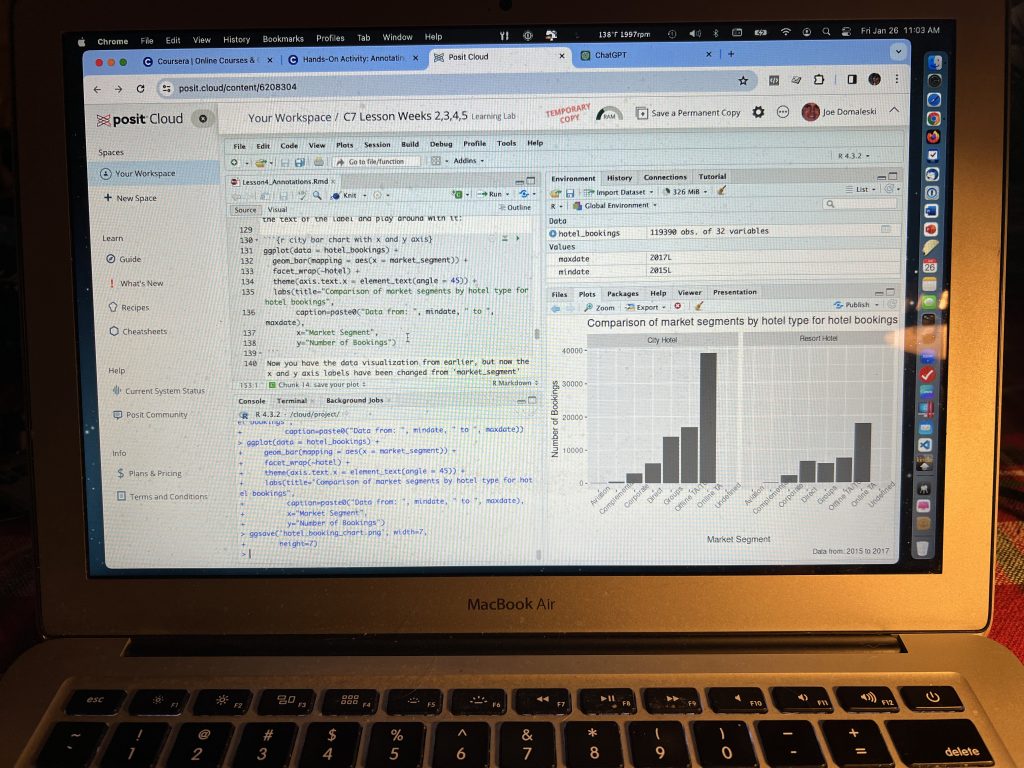
The author uses Artificial Intelligence (AI), statistics, R programming, and creativity to solve a marketing problem. Photo/Joe Domaleski
Underneath the hood, most AI is based on different types of algorithms (such as regression, decision trees, support vector machines, clustering, and neural nets) and mathematical representations of knowledge (mostly probability, statistics, linear algebra, and calculus). Is AI creative? Yes, if you accept the definitions of AI at the top of this article – AI is creative. It does have the ability to consider existing knowledge and identify new patterns to create things. Does that bother me? No. While it’s true that we live in a world defined by math and science, we have something AI does not. AI does not have a soul, and we do.
Expression, creation, and innovation based on soulful creativity is the wave of the future. It’s literally what helped us get this far as a species, and I believe it’ll serve us well as we head into an uncertain future with or without AI. Creativity is so important to me that I made that part of our company name (Country Fried Creative) years ago. Creativity is literally what keeps the world moving in a forward direction.
How do you use creativity in your personal and professional life?
[Joe Domaleski, a Fayette County resident for 25 years, is the owner of Country Fried Creative – an award-winning digital marketing agency located in Peachtree City. His company was the Fayette Chamber’s 2021 Small Business of the Year. Joe is a husband, father of three grown children, and proud Army veteran. He has an MBA from Georgia State University and enjoys sharing his perspectives drawing from thirty years of business leadership experience. Sign up for the Country Fried Creative newsletter to get marketing and business articles directly in your inbox. ]
by Joe Domaleski | Mar 11, 2024 | Blog, Business, Columnists, Community, News Center, Opinion
Last week, a friend of mine, who rarely calls me, did that very thing. Noticing that it wasn’t a spam call, I answered. He asked me a simple non-work-related question, but I didn’t have the answer.
The dialogue went like this:
My friend asked, “Do you know when the next meeting is?”
“I’m not sure, but I know it’s on the website,” I replied.
He insisted, “I don’t have time to look at the website. I’m standing here with someone who wants the answer right now.”
“Well, I think as soon as we hang up, you can probably pull it up on the website. The website works fine on mobile phones. I believe the information you seek is on the home page in the top right corner if memory serves correctly.”
My friend pushed harder, “Look, I don’t have time to load the website on my phone. Do me a favor and as soon as we hang up, will you look it up for me and then call me back with the information?”
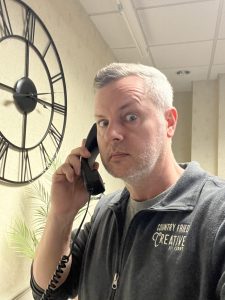
The author on the phone. Photo/Joe Domaleski
“Are you in distress?” I asked.
“No, why would you say that?” he replied.
“Well, I just don’t understand why you don’t have time to look something up on the website, and we’ve been talking about it for the past few minutes. As soon as we hang up, you could have the information immediately if you looked it up yourself. If I had known the answer to your question, I would have told you, but I don’t. However, I know you can find the answer on the website,” I stated.
My friend got a little testy, “I don’t know why the answer to everything is to look it up online. I’m too busy to fool around with websites. I’ll just call someone else.”
“Hey, before you go, quick question – why did you call me instead of someone else?” I asked.
“Well, Joe, you’re always so well informed. You seem to be plugged in and know what’s going on in the community. I figured you’d just tell me what I needed to know.”
“Fair enough, talk to you later,” I answered.
We ended the call, and I stood there stunned. Honestly, I’m not sure if I should be flattered that he thought I knew the answer to his question or feel foolish that I’m enabling lazy behavior. Maybe I just read too much into the situation. I wanted to tell him the reason I’m well informed is that I seek out information instead of waiting for it to be spoon-fed to me. I know that the information he asked about was sent out several times via email, and it’s on the organization’s website along with other events. This situation got me thinking about whether staying informed is a privilege, a responsibility, or both.
The fact that you, dear reader, are reading this article indicates that you are probably someone who seeks out information on your own. You’re to be commended for that. Have you encountered situations like the one I described above? Does it frustrate you, or do you enjoy being a conduit of information? I like being helpful, I really do. An occasional “lazy question” from a friend doesn’t bother me, and I’ve probably done my fair share of that when I can’t find something – but I always start with the premise of trying to find information myself. I can’t imagine waiting for information to find me.
It’s a privilege in our great country to have access to information – we have a free press, (mostly) open government, the right to free speech, and the increasingly wild world of online information via websites and social media. If you wait for a computer algorithm to serve up the information it thinks you need to know, then you’re going to be trapped in an illusory world of make-believe. Burst the bubble of misinformation and take responsibility for your information. A few weeks ago, I listed some of my favorite news sources, and that spurred some great dialogue where I learned about even more places for information.
Don’t abdicate your responsibility to stay informed. Be deliberate in knowing what’s going on around you – at home, at work, in the local community, and in the world at large. Be mindful of rumors, gossip, and speculation. Always seek the truth from a diversified set of information. Things are rarely black and white. Truth is often nuanced because it has to go through a human filter.
Here are some tips on staying educated and upholding your responsibility to be an informed person:
- Use technology to your advantage and automate your information gathering. Most modern organizations, including this newspaper, put out email newsletters. Sign up for them and let information come to you. Even if I don’t immediately read an email newsletter, I have it there for reference. Our local Chamber of Commerce, municipalities, and government officials put out information regularly.
- Develop good information-gathering habits. I make it a point every day to keep up with the news by having it as a task on my daily to-do list to remind me (note: I use Things 3 for MacOS and iOS for task management).
- Seek diversified opinions and advice. Don’t let others tell you what to think. Evaluate evidence and formulate your own opinions. Most people do not have access to “the big picture” of any situation.
- Avoid gossip and rumors. Gossip is rarely true, although it may have at one time been based on a nugget of truth. When you hear a rumor, an immediate concern should be “why is this person telling me this?” Are they trying to sabotage someone or something? Are they bitter about something? Is there a legitimate concern that should be investigated further? If you believe a rumor has merit and may impact you, then seek out the truth. We live in a small community, and what goes around comes around. Don’t become known as a gossiper.
- Withhold opinions unless there’s a need to express them. Some things are better left unsaid. I have a hard time with this personally because I like to talk and engage in discussions. Indeed, I’m a professional marketer, so it’s my business to promote things and be communicative. Discretion is advised. Just because you hear a rumor, questionable assertion, or obviously biased statement doesn’t mean you need to weigh in on it. We’ve all gotten sucked into “flame wars” by internet trolls. Just walk away unless there’s a very compelling reason to chime in. If someone says something blatantly false about someone or something I care about, I will take a stand – but not everything warrants that.
- Trust, but verify. In general, I tend to trust people and assume the best of everyone – sometimes to my detriment. Life is too short to be mean and challenge everyone directly. On the other hand, taking responsibility for information means verifying its truth. This is especially difficult if you’re a leader who relies on the advice and information from others in an organization. Last year, I made the mistake of relying on someone who I thought was doing their job but wasn’t. It created an awkward situation that required a careful solution. The good news is that the situation was resolved, and we learned from it.
- Don’t be a burden to others. No one enjoys the needy friend who is always asking everyone what’s going on because they’re too lazy to find out for themselves. If you do need help, let others know you tried to find out the information and what you were able to find. Doing that shows you are committed to an answer and may help the person you’re asking to better understand the context of your question.
Staying informed is a privilege and responsibility that demands both curiosity and diligence. In an earlier article I wrote about the importance of data. Whether it’s a rumor, meme, blog post, or an opinion from an individual person we know that a single data point is not enough information to develop any sort of credible opinion. Avoid gossip, rumors, and speculation that that’s overtly negative. Developing a hypothesis or trend line requires multiple data points. Seek out information from a wide variety of sources and do so regularly. Doing so will help you better understand the world around you. Being well-informed is not just for our benefit but it also helps our community when we have an educated citizenry.
How do you stay informed?
[Joe Domaleski, a Fayette County resident for 25 years, is the owner of Country Fried Creative – an award-winning digital marketing agency located in Peachtree City. His company was the Fayette Chamber’s 2021 Small Business of the Year. Joe is a husband, father of three grown children, and proud Army veteran. He has an MBA from Georgia State University and enjoys sharing his perspectives drawing from thirty years of business leadership experience. Sign up for the Country Fried Creative newsletter to get marketing and business articles directly in your inbox. ]
by Joe Domaleski | Mar 4, 2024 | Blog, Business, Columnists, Community, Front Page, News Center, Opinion, Top News
So you’ve made a mistake, now what? You’re not alone, although you may feel that way. I’ve made many mistakes and blunders over the years. No one is perfect. Leaders are often criticized by “armchair quarterbacks” who are not privy to the complete details of a situation. Entrepreneurs are especially vulnerable to mistakes because they’re usually “all in” financially, which makes mistakes extra painful. Unlike a large organization where one may be spending someone else’s money, the small business owner or nonprofit executive is totally at risk when making decisions. Here are some common mistakes that leaders, including myself, have made:
- Failure to communicate effectively: This is probably the source of more mistakes than anything else. Whether you’re communicating with your team or with a client, it’s essential to have clear communications. Although verbal communication is often the most effective way to collaborate with people, if you’re running a business, it really needs to be followed up with written documentation to ensure clarity. Memories tend to be selective, especially when dealing with complex issues.
- Avoiding tough decisions: I’m guilty of this, and it’s something I work on constantly. I tend to be optimistic and hold on to things longer than I should. A leader doesn’t need to be reckless, but they do need to be decisive. Doing so inspires confidence and clarity. Not doing so can lead to problems down the line. Once you have all the facts you need, make the decision. I’m not alone in this regard. I know a lot of leaders struggle with procrastination.
- Inflexibility and lack of adaptability: Most leaders tend to be older and have experiences which helped them to get where they are, but may not be enough to get to where they need to be. The world is a rapidly changing place, and what worked yesterday may not work tomorrow. A lack of adaptability can hinder company growth, stifle emerging leadership within an organization, and cause problems with clients who need newer solutions.
- Delegating too much or too little: I’ve written previously about delegation, and it’s one of the hardest things to get right. If you delegate too much, your team may not have enough guidance to go in the direction you want. On the other hand, too little delegation will run the leader ragged and stunt the growth of a high-powered team. Improper delegation can lead to all kinds of errors and mistakes internally and externally.
- Moving too quickly or too slowly: Pacing is an important concept when working with other people. Moving too fast on something may leave people behind or expend resources wastefully on a market opportunity that’s not quite ready. Moving too slowly can cause an organization to “miss the boat” on profitable and beneficial opportunities. When working with a team or a client, it’s important to make sure everyone is “on board.”
- Failing to give and receive feedback: When something isn’t quite right, it’s important to speak up so that a situation doesn’t get worse. Most people don’t try to make mistakes, but if one is being made, it’s important to say something in the spirit of improvement. This helps people improve non-optimal circumstances. Maybe more importantly for the leader is to have the ability to receive proper feedback. A wise leader seeks counsel from trusted advisors and input from people at all levels of an organization. When giving or receiving feedback, it’s important not to get into a “blame game”. We all know people who are never wrong, like to spread rumors, and are very quick to point fingers at others. Avoid those people.
- Misallocating resources: Doing the right things, at the right times, for the right reasons, with the right resources is not easy. Just about everything a business does involves time, money, and people. Knowing how much time to spend on things, how much money to invest in projects, and knowing which people to assign to tasks is both an art and a science. For a small business or nonprofit, cash flow management in particular is extremely tough (this is true in many households as well). Usually, no one but the accountant and the business owner knows the big picture. Even with good intentions, sometimes a leader doesn’t get it quite right with resourcing.
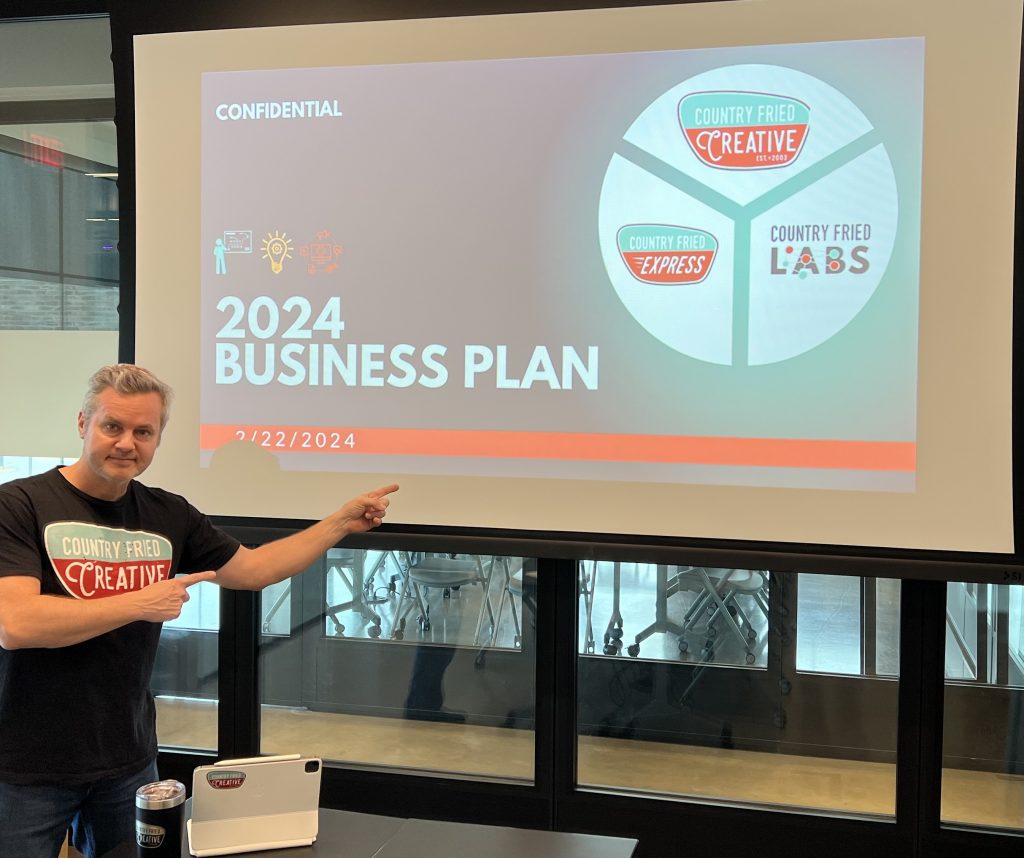
The author Joe Domaleski leading a recent company meeting where challenges from the prior year were acknowledged with a plan for making things better in the new year. Photo/Mary Catherine Domaleski
I won’t go into details, but last year, I made some mistakes with my business. Lessons have been learned, changes have been made, and we’re moving forward in this new year. What follows are suggestions that I try to follow on how to fix mistakes and move on:
- Accept responsibility for the mistake: A true leader acknowledges and takes responsibility for mistakes they or their team make. Accepting responsibility should be done clearly and without deflecting blame. Unfortunately, many so-called leaders in society do the opposite and blame everyone but themselves. That’s not leadership. Although it’s rare, there is one exception to this rule – if you’ve been advised by an attorney not to admit fault because a legal issue is at stake. That should be the only exception.
- Understand the impact of the mistake: Most mistakes have consequences. Quickly and completely assess how the mistake has impacted your team, your customers, and your organization. Doing this will help you determine what needs to be done to fix the situation.
- Apologize for the mistake: Mistakes often impact other people. If that’s the case, an apology shows respect to those affected as well as a commitment that amends will be made. Not everyone will accept your apology. If that happens, it’s on them – not you.
- Fix the mistake: Taking appropriate corrective action demonstrates that you are willing to “right the wrong.” This may involve a refund or discount to an affected customer, a proper allocation of company resources to a project, or a reassignment of team members to better maximize everyone’s strengths. It could also mean that company policies and procedures need to be adjusted to avoid a recurrence of the problem.
- Learn from the mistake: Non-lethal mistakes are learning experiences. People rarely learn from wins, in fact quite the opposite often happens. Don’t get me wrong, it’s great to win, but there’s a downside. Constant winning can lead to complacency and stagnation. Nothing lasts forever, especially not in the business world. Think of all the failed businesses who thought they were immune from losing. Most learning and improvements come from mistakes. Determine the root cause of the mistake and gain insights from it to make you and your organization more resilient in the future.
- Forgive yourself for the mistake: This is the hardest thing to do. No one likes to make mistakes, but we all do. Yes, because you’re the leader, there will be some who are quick to criticize your mistakes, and that makes it hurt even more. Forgive them, but especially forgive yourself. Once you’ve accepted responsibility, apologized, and fixed the mistake, it’s time to move on with new knowledge and a clear conscience. Don’t let the past weigh you down; allow it to fortify your list of experiences to better prepare you for what’s ahead.
Making mistakes is no fun, but it’s part of the journey. Over the years, I’ve made many mistakes, and I’ll probably make more in the years ahead. Handling mistakes as a leader requires maturity, accountability, and commitment. When everything is going right, it’s easy for people to take credit. When things go wrong, most people like to point fingers and ascribe blame. Unlike what we often see in today’s “me first” society, a true leader gives credit to their team for the wins but accepts responsibility for the mistakes and losses. Once a leader accepts responsibility and apologizes, it’s time to fix the problem and move on. I think the hardest part of righting a wrong is forgiving yourself. Don’t carry the baggage of guilt into the future; it’ll only hold you back from improvement. Let mistakes toughen you up and prepare you for what’s ahead. We need more accountable leaders who lead with head, hands, and heart. Will you join me in being that type of leader?
[Joe Domaleski, a Fayette County resident for 25 years, is the owner of Country Fried Creative – an award-winning digital marketing agency located in Peachtree City. His company was the Fayette Chamber’s 2021 Small Business of the Year. Joe is a husband, father of three grown children, and proud Army veteran. He has an MBA from Georgia State University and enjoys sharing his perspectives drawing from thirty years of business leadership experience. Sign up for the Country Fried Creative newsletter to get marketing and business articles directly in your inbox. ]
by Joe Domaleski | Feb 26, 2024 | Blog, Business, Columnists, Community, Front Page, News Center, Opinion, Top News
Every Friday morning, a group of our friends gets together at 7am to have breakfast and chat at a local restaurant. We talk about a lot of different things, but last Friday (2/23/24), many of us decided to talk about the massive AT&T cellular network failure that occurred the previous day. We noted that it was hard to get news about what was going on. Indeed, AT&T wouldn’t even acknowledge the issue until it was almost resolved six hours later. What little news that was being reported was inaccurate and incomplete. That discussion led to a more general discussion about how and where each of us reads the news. The discussion we had inspired this article.
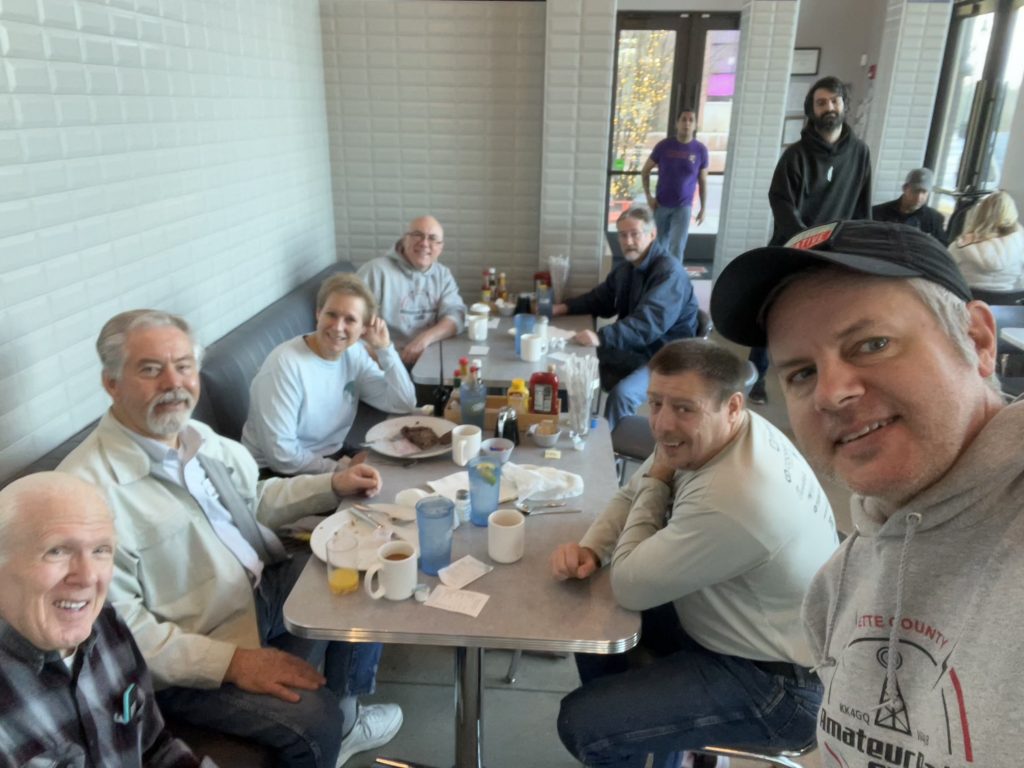
Some of my friends gathered for breakfast and conversation at Thumbs Up Diner – Trilith/Fayetteville. Photo/Joe Domaleski
Before getting into specific news sources, it’s important to put my recommendations into context by addressing the topic of bias. News reporting always has some kind of inherent bias, even if it’s unintentional (which is rarely the case). Reporters and editors are people who are influenced by their own experiences, perspectives, culture, beliefs, and socioeconomic backgrounds. Besides the people reporting the news, the organizations that publish or broadcast the news also have to cater to their target audience and advertisers.
Be on the lookout for specific types of fake news and bias, including:
- Clickbait – designed to grab attention and get clicks. Most social media news falls in this category.
- Propaganda – created to mislead audiences. This is increasingly becoming a problem with the influence of foreign agents.
- Satire/Parody – unfortunately, I think modern society has a hard time distinguishing between parody and truth. Satire is a dying art.
- Sloppy journalism – in which incomplete stories are published without fact-checking. Be advised that most generative AI models don’t know how to fact-check and many reporters don’t either.
- Misleading headlines – there’s a fine line between a proper headline that brings attention to something and one designed to mislead people.
- Biased/Slanted News – people are often drawn to stories that confirm their own beliefs or biases (called confirmation bias), and fake news can prey on that predisposition.
- Unreliable/False Sources – stories that rely on questionable sources, rumor, or hearsay. ALWAYS check cited sources when reading a news story.
Traditionally, news outlets selected what stories to publish and how to frame them, as is done with this website you’re reading right now. With the advent of AI, algorithms largely determine what we see in most online news outlets. Algorithms are designed to promote popularity. These computer-generated publishing agents assume that if something is popular and fits your profile, then you want to see more of it. Doing so reinforces echo chambers, confirmation bias, and causes a general lack of perspective. That’s not universally true, and just the opposite situation occurred last week. Google’s new Gemini AI ran into problems by doing the opposite and pushed false diversity narratives with a black George Washington and other historical falsehoods.
Recognizing and understanding bias is important. Here’s my own bias when it comes to the news:
I believe it’s important to use discernment and consult a variety of news sources to get a broader perspective, even those sources that don’t line up with my worldview.
Okay, with that out of the way, here’s my recommendations on top news sources for staying informed.
- WSB Radio morning news show – Broadcasting on FM 95.5 / AM 750, this excellent news program has it all – news, weather, traffic, and short interviews. It’s very convenient for Mary Catherine and me to get caught up on the news while we’re drinking coffee and getting ready for the day. Later in the day, WSB Radio has politically opinionated radio shows, but the morning news program is excellent and non-political. Highly recommended investment of five minutes of your time daily.
- BBC World News – with a variety of free digital and broadcast formats, the BBC is a great source of world news. It’s so good that many US-based NPR radio stations license their content and rebroadcast it for a US audience. I don’t always have time to review the world news, but when I do, I start with the BBC.
- USA Today – with its easy-to-read graphics, short articles, and emphasis on news over opinion, this is about as centrist as it gets when it comes to news (unless you consult a newswire like Reuters). When I skim USA Today, I feel like I get a good overview of what’s going on in our nation.
- New York Times – Yes, it’s very well known that the New York Times tends to display a left-leaning, liberal bias. Yet, it’s also well known that the “old gray lady” of news still has some of the best writing, features, and content. They also have cool puzzles like Wordle and the famous New York Times Crossword (any fellow cruciverbalists out there?). I pay for a subscription to this so I can read it on my iPad. Reading the Sunday edition is a tradition I’ve kept for many decades.

Starting my day by reading the online edition of the New York Times on my iPad. Photo/Joe Domaleski
- Wall Street Journal (WSJ) – The absolute best source of business news and features is the WSJ. The stock market data isn’t as useful as it once was because there are so many other sources for that, but everything else is relevant and useful. The opinion pieces definitely lean to the right, with well-reasoned conservative viewpoints. The technology column is especially good. If you’re a business leader like me, then the features about leadership and management are also excellent.
- Local government / School system – All of our local municipalities, including the school system, have excellent websites, newsletters, and social media channels. The Sheriff’s Office has an excellent app for your smartphone to alert you to situations, like the shutdown of Hwy 314, which occurred on Saturday. They also echo NWS weather alerts. Sign up for your free, tax-dollar-supported news. With the exception of the Sheriff’s Office, most of the other entities tend to report on events and updates, not necessarily controversial or breaking news. Honestly, that’s not really their job, and they leave that to the next recommended news source.
- TheCitizen.com online – yes, this newspaper website right here is one of your best sources of local news. Totally owned, operated, and funded by people in Fayette County, this is truly an institution not beholden to any particular special interest. The paper makes a clear distinction between news and opinion columns. Because the publisher of this paper believes in free speech, the opinion section can get a little heated at times. Truth is, anyone can write in, and it remains the most popular section. I don’t agree with many of the things published in the opinion section, nor am I required to do so. My own weekly columns are purposely non-political, and I appreciate everyone who takes the time to read them. There’s also the Fayette News, which is owned and operated from Thomaston.
Sometimes breaking news will show up in a questionable location, which inspires me to consult one of the trusted news sources above. I wouldn’t totally rely on the following sources, but they may alert you to something that may warrant further research.
- Twitter / X – probably the best source of breaking or emerging news on the national or international level. When the AT&T network went down last week, this was the first place that reported on it. There’s a lot of misinformation, parody, satire, and bias on Twitter / X – so use with caution.
- Facebook – not my favorite social media platform and definitely not my primary source of news, but often times the source of local, breaking news. Many people in our community hang out in one of the popular county and city Facebook groups. When folks aren’t griping about something, you’ll occasionally hear about something newsworthy pending confirmation from a trusted source. Our local government organizations, school system, and public safety all put out news on their Facebook groups. Besides keeping up with your friends and neighbors, it’s also a decent place to find out about community events.
- Traditional TV / Cable media – Before the rise of Internet news, many of us middle-aged people (and older) watched the news on local TV stations and larger cable networks such as CNN, CNBC, and Fox News. The cable news outlets are well-known for bias, but that’s not the reason I don’t watch them anymore – it’s just not convenient. Being able to pull out my iPhone and skim the news – or – have it read to me using a text-to-audio app just makes it more convenient.
- NPR / GPB News – I really want to like NPR and will listen from time to time. Because they’re trying so hard to be diverse in their programming, it often means that the news they’re reporting on isn’t relevant to me. Market Watch is pretty good for business news. GPB news has excellent state-level news coverage, and I should probably listen to that more often.
- RSS Feeds – I also periodically use an RSS news feed reader called Feedly. It aggregates and pulls news from different online sources via RSS feeds or web scraping. There are other systems out there like Reeder, Apple News, Flipboard, and Readwise who work similarly. Systems like these are very useful, but can be overwhelming. The main advantage is that they can list the headlines in a very useful way so that you can click on them to explore further.
On the subject of news, I’d also encourage everyone to sign up for free NWS weather alerts. Whenever there’s a bad storm, I normally get three alerts at a minimum – a text message, audible siren outside, and my weather radio will signal an alert. Staying informed about the weather could save your life. You can get more information about weather alerts from the NWS Peachtree City / Atlanta website.
It’s more important than ever to stay informed about what’s going on in our local community and beyond. I’d encourage you not to rely solely on algorithms to serve up what they think is important or trendy. Take charge of what you see, read, or hear. Seek out reputable information and news by using a wide variety of sources and formats. For me, that means starting the day with good, old-fashioned radio news. Reading online news and information sites from different sources (and perspectives) helps me gather information to make better decisions. I like to form my own opinions about what’s going on in the world around me. An informed society contributes to a healthier democracy.
What are some of your favorite sources of news and information?
[Joe Domaleski, a Fayette County resident for 25 years, is the owner of Country Fried Creative – an award-winning digital marketing agency located in Peachtree City. His company was the Fayette Chamber’s 2021 Small Business of the Year. Joe is a husband, father of three grown children, and proud Army veteran. He has an MBA from Georgia State University and enjoys sharing his perspectives drawing from thirty years of business leadership experience. Sign up for the Country Fried Creative newsletter to get marketing and business articles directly in your inbox. ]
by Joe Domaleski | Feb 19, 2024 | Blog, Business, Columnists, Community, Front Page, News Center, Opinion, Top News
Recently, my company had the pleasure of speaking about marketing at the third annual Coweta County Nonprofit Summit. After the presentation, one of the attendees approached me to ask some questions. She was a volunteer board member attending the conference to get information for her nonprofit but told me that her “real job” was operating a small business in Newnan. She had been struggling with marketing her business to get new customers and wondered what could be done. Instead of answering the question outright, our dialogue just kind of naturally developed into a chat about marketing mistakes that I had seen people (including myself) make over the years. I thought the dialogue we had might make for a good article.
What is marketing? Here’s the most straightforward definition I have:
Marketing = Promotion.
Typically, marketing is directed at promoting activities that lead to the exchange of money, such as the sales of products or services. If you’re a nonprofit, then marketing might be used to solicit donors and sponsors. I used the word “typically” on purpose because marketing doesn’t always involve a sale or donation. Marketing may be used to promote free community events, foster general awareness of an idea, or recruit volunteers. When I was in graduate school 30 years ago, I learned there was a Marketing Mix called the “Five P’s of Marketing” – Product (or Service), Place, Price, Promotion, and People. Some experts have expanded it to “Seven P’s,” including Packaging and Positioning. I’ve heard others refer to only “Four P’s.” Regardless of how many P’s are added to the mix, let’s just stick with “Promotion” for simplicity.
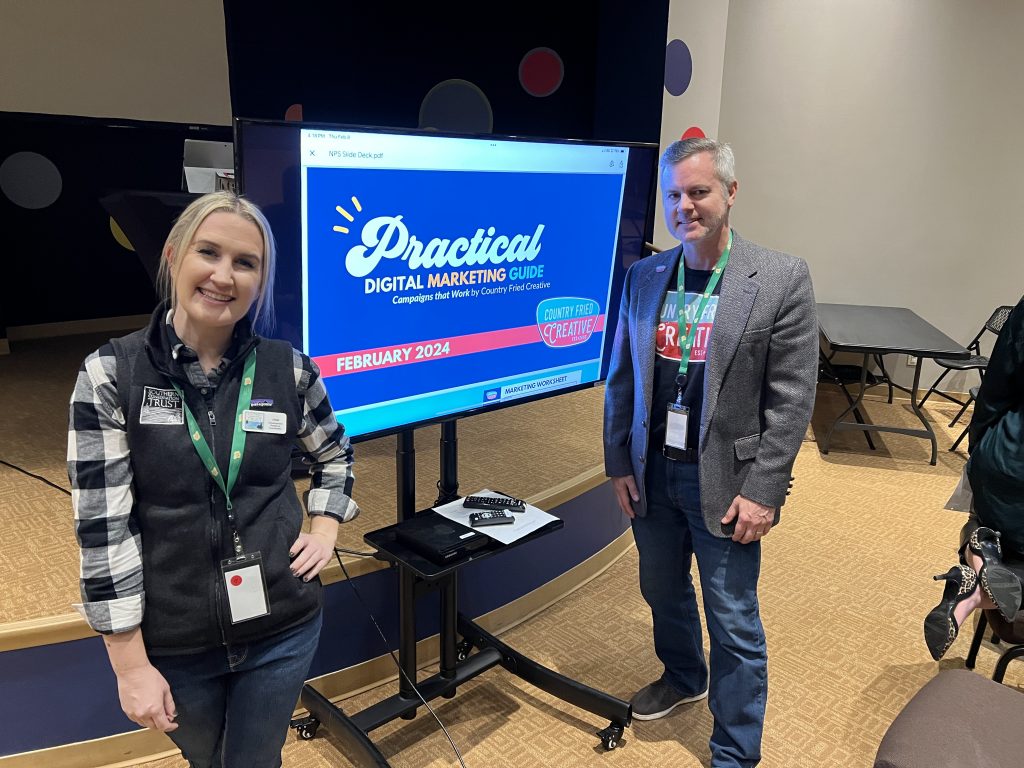
The author Joe Domaleski (on the right) with Southern Conservation Trust Community Relations Coordinator Josie Saunders at the 2024 Coweta Nonprofit Summit. Photo/Joe Domaleski
As a society, we need good marketing. It’s what allows us to find things of interest like household goods, restaurants, service providers, Churches, community activities, volunteer opportunities, entertainment options, and even community news. If you are a business owner or nonprofit leader, then you need marketing to create awareness so that people can find you. One of the reasons I started a marketing agency twenty years ago is so that I could help foster better community dialogue between businesses, nonprofits, and residents. This became especially important during COVID. As people were hunkered down at home in front of their computers, online marketing became a lifeline for both businesses and consumers so that people could see what was open.
The best forms of marketing are natural and relevant. No one likes creepy marketing that stalks you online. You can overdo marketing. It’s also true that most all businesses are marketing even when they think they aren’t. My all-time favorite phrase I sometimes hear from fellow business owners is, “I don’t believe in marketing. We’ve got more than enough business.” That’s wrong on so many levels. Do you have a sign outside your business? Do you have a logo, business cards, and letterhead? If so, then you’re marketing – but probably not enough.
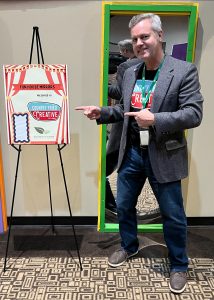
The author promoting his business Country Fried Creative with signage at the 2024 Coweta Nonprofit Summit. Photo/Joe Domaleski
Now that we know what marketing is and why we need it, let’s examine ten of the most common marketing mistakes made by local, small business owners (and nonprofits). As a local business owner, I have made most of these mistakes myself.
- Marketing without a plan. This is the most common problem I see, and it’s still amazing to me that many organizations sort of stumble around with an outdated website, sporadic advertising, inconsistent branding, and no plan whatsoever. This wastes time and money. At a minimum, an organization needs to have a written plan to define their marketing target, goals, activities, budget, and performance measures. I’ve seen great one-page marketing plans, although most tend to have a little more detail. What I hear a lot of the time is, “We don’t want to be bothered with a plan. Just make us #1 on Google and get us leads.” You can’t do it without a plan.
- Getting sales confused with marketing. Marketing is not the same thing as sales. You can fight me on that one. We’ve established that marketing is promotion and it helps create the conditions for a sale. The sale happens when someone actually buys something, which could be in person or online. Many companies mistake the two terms and over rely on marketing to make up for bad sales practices. You need both marketing and sales. Great marketing helps create conditions for a sale, but it’s not the sale itself. In a previous article, I said that sales is the most important function of a business, and I stand by that statement, but sales is not marketing.
- Putting too much reliance on referrals. Make no mistake, referrals are often the best source of marketing for a small, local business. Even as a marketing agency, about 80% of our prospects come from referrals. However, referrals aren’t enough to sustain a business. Good marketing helps convert referrals into potential customers. Almost all referrals will look at a website to gain insight into a company’s quality, authenticity, and relevance. What happens when the referrals stop coming in? Businesses should promote themselves using a wide range of marketing channels such as social media, newsletters, advertisements, and signage to name a few. Don’t put all of your eggs in one basket.
- Underestimating the importance of quality. Your target market will form an immediate impression about your organization based on the quality of what they see. Avoid the temptation to scrimp with AI-generated written content, poor quality images, pixelated logos, and outdated information. When I see things like “Free website by Wix” in a website footer or “Get your free 50 business cards by Vistaprint” printed on the back of business cards, then that tells me that the business is not serious enough to invest in themselves. You only get one first impression. Strive for quality so that you stand out in a noisy world.
- Failing to keep online information accurate. I know this is a pet peeve for anyone trying to find information online. It’s essential to keep your contact information, hours of operation, location, and company information consistent on your website, social media, business directory listings, and signage. People won’t come to your restaurant if the website says you’re open at 7am for breakfast, but your Facebook page says 8am. Make it a regular habit to audit your online “points of presence” to make sure they’re consistent.
- Missing out on opportunities for free marketing. Yes, there really are ways to market inexpensively and sometimes free. Asking people to refer your business, claiming your Google business listing, volunteering in the community, and creating ways for people to find you are all great ways for marketing on a shoestring budget. Marketing doesn’t have to be expensive, but it does have to be consistent. Networking in the community is one of the best free ways to market your business, and it’s how I built my company.
- Over relying on free/cheap marketing. Free is good, but it’s not enough. There’s no getting around investing money and resources to make sure your business has customers. Set a monthly budget and invest a fixed amount each month to promote your business. From time to time, you may want to spend a little more for special events and promotions, but consistently spend and see what works best for you. You’ll be invisible if you don’t spend something on marketing because your competitors will.
- Avoiding advertising and paid promotions. One of the most effective ways to get your message out to your target market is to invest in advertising, especially digital advertising. With digital advertising, you can be very specific about who sees your message and how much you want to spend on it. Better yet, you can actually track how many people take action, so you can measure the return on your investment. That’s harder to do with traditional print advertising. The key to advertising is consistency and relevance. Advertising in this online newspaper is a great way to reach a local audience.
- Neglecting brand consistency. Don’t be that business or nonprofit that has different versions of your logo on your signs, shirts, website, and print material. Quality is important, but don’t fall into the trap of merely “elevating your brand” by prioritizing style over substance. Yes, style is important, but make sure it’s sustainable with consistency. Inconsistent branding will confuse your target market. Consistency in high-quality visuals, tone, and messaging reinforces brand recognition and loyalty.
- Ignoring analytics and attribution. It’s still amazing to me that many business leaders have no idea how many visitors they have on their website or what their marketing return on investment is. You can’t manage what you can’t measure. “Well, they said they heard about me online” is not analytics. Use analytics to track the effectiveness of your marketing activities so that you can focus on what works and eliminate those activities that aren’t working.
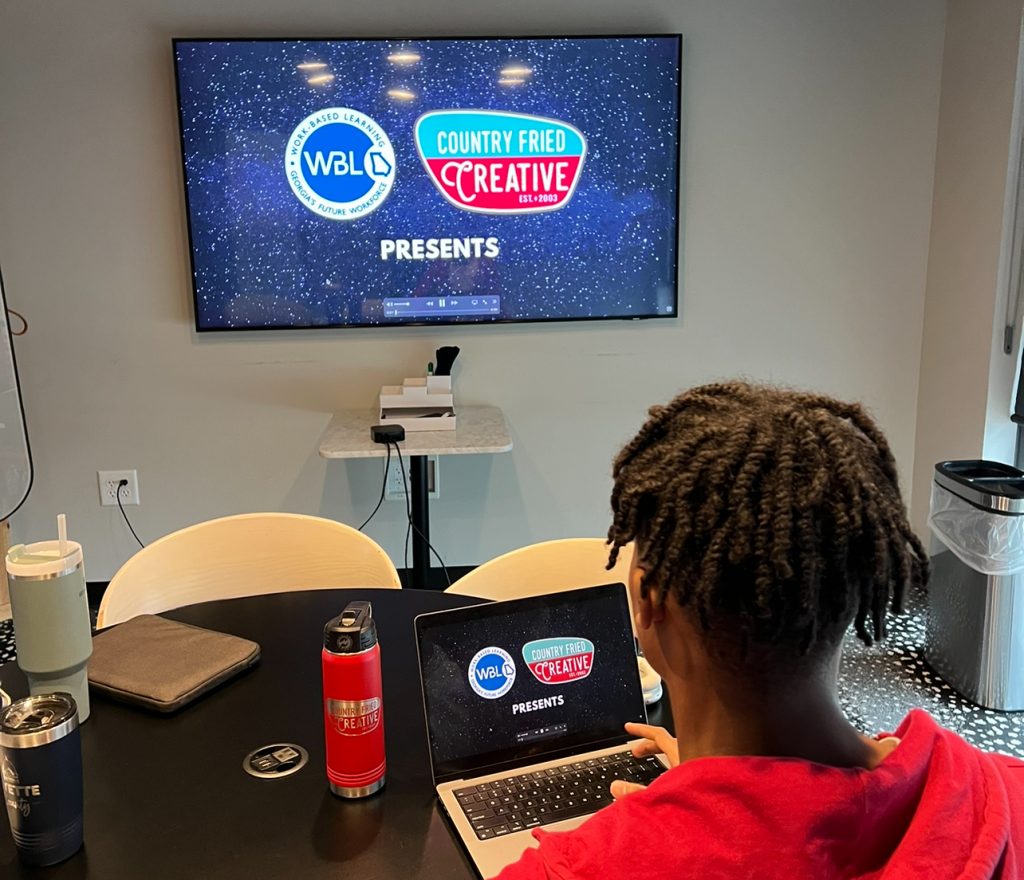
Intern Zavion Green, a senior at Sandy Creek HS, works on a promotional video for the Fayette Schools Work-based Learning program and Country Fried Creative. Photo/Joe Domaleski
We all need marketing! If you’re a business owner, you need marketing to help promote your products and services to the right target audience. If you’re a nonprofit leader, you need marketing to solicit donations and garner support for your cause. If you’re a consumer, you need marketing to help find what you’re looking for efficiently and effectively—and occasionally discover things you didn’t know you needed. Marketing is both an art and a science that promotes your organization in a creative and methodical manner. Be deliberate with your marketing activities, ensuring high-quality and consistent messaging that is both measurable and adjustable for optimal impact.
I look forward to seeing how your marketing efforts make an impact in our community.
[Joe Domaleski, a Fayette County resident for 25 years, is the owner of Country Fried Creative – an award-winning digital marketing agency located in Peachtree City. His company was the Fayette Chamber’s 2021 Small Business of the Year. Joe is a husband, father of three grown children, and proud Army veteran. He has an MBA from Georgia State University and enjoys sharing his perspectives drawing from thirty years of business leadership experience. Sign up for the Country Fried Creative newsletter to get marketing and business articles directly in your inbox. ]









